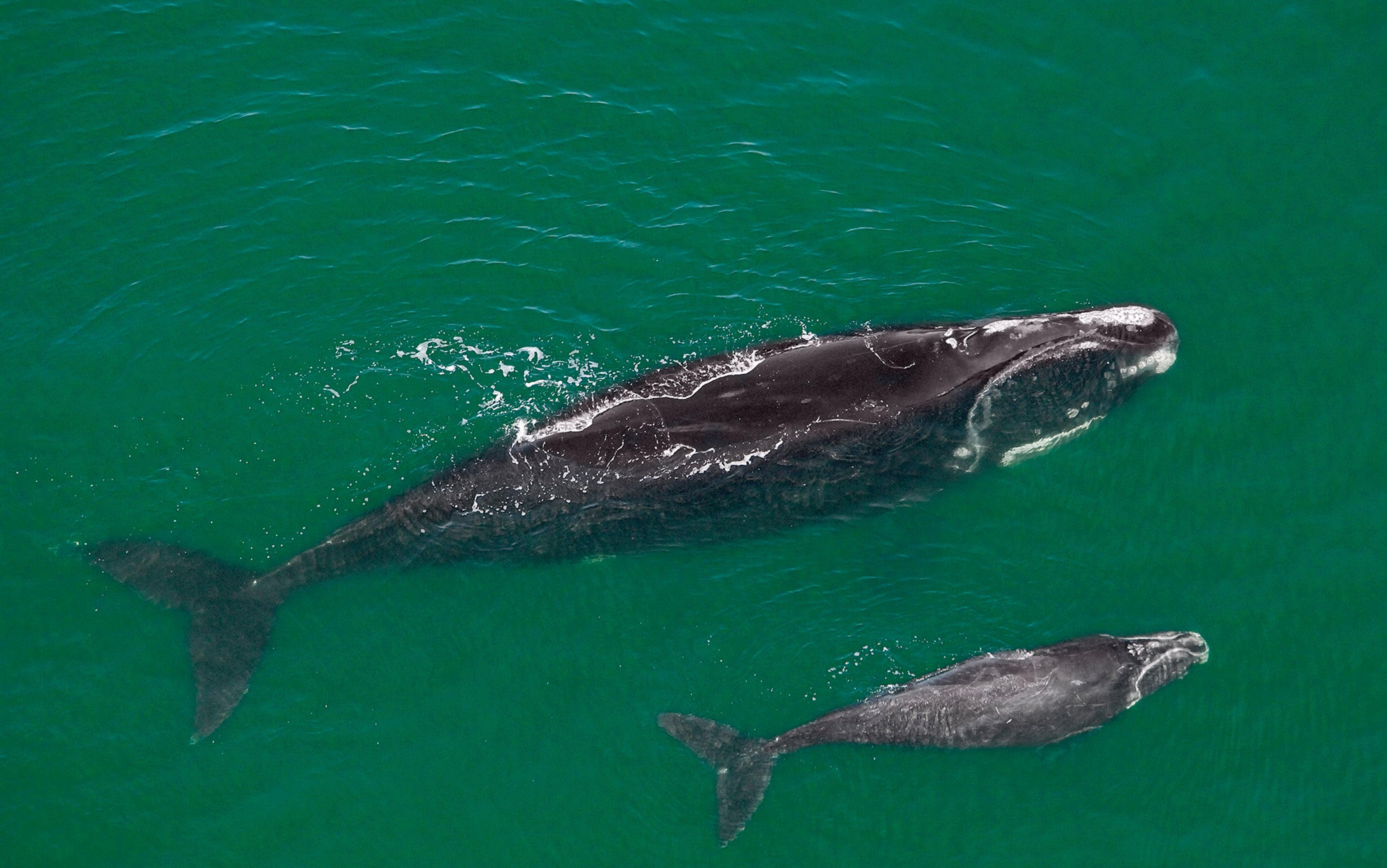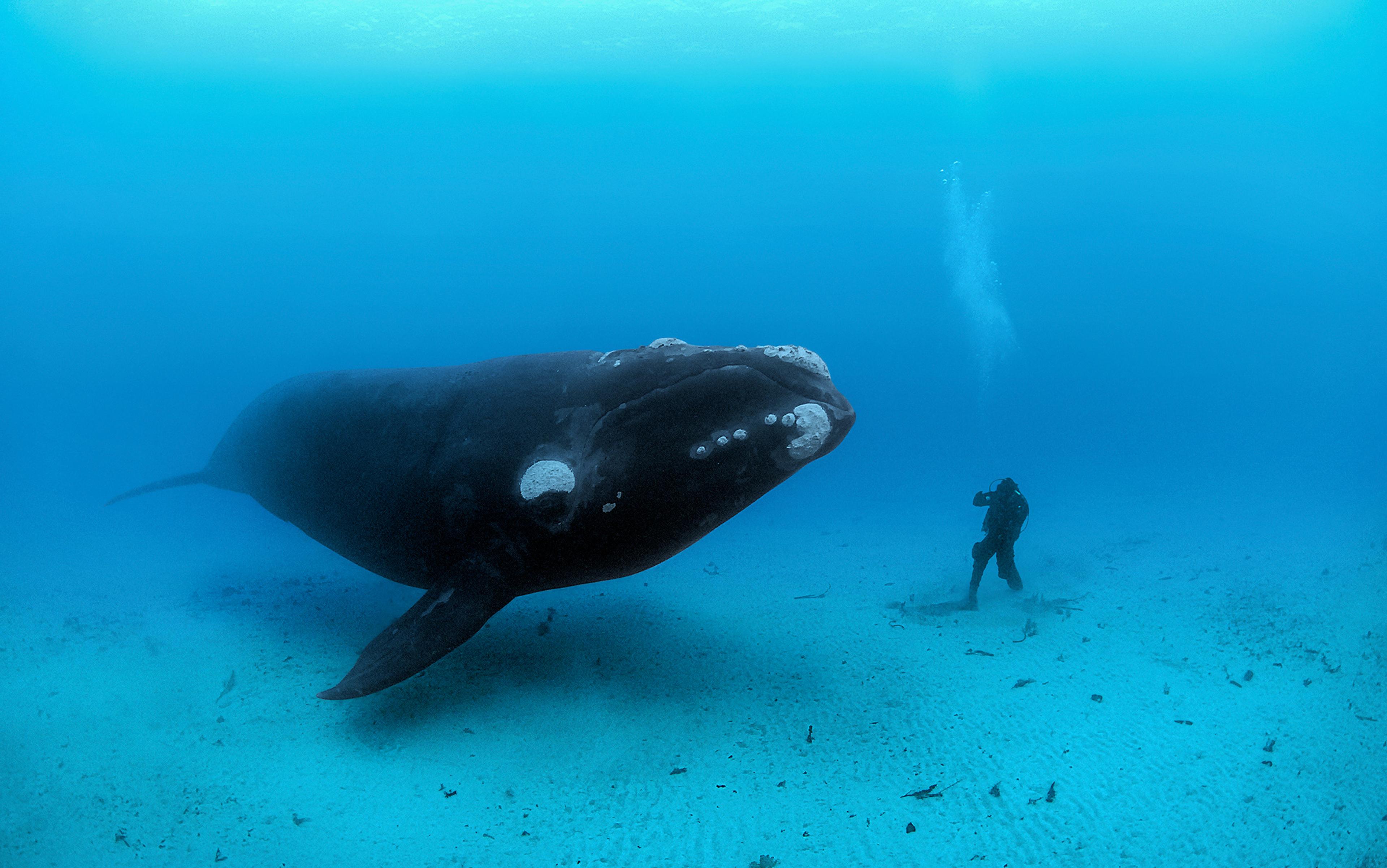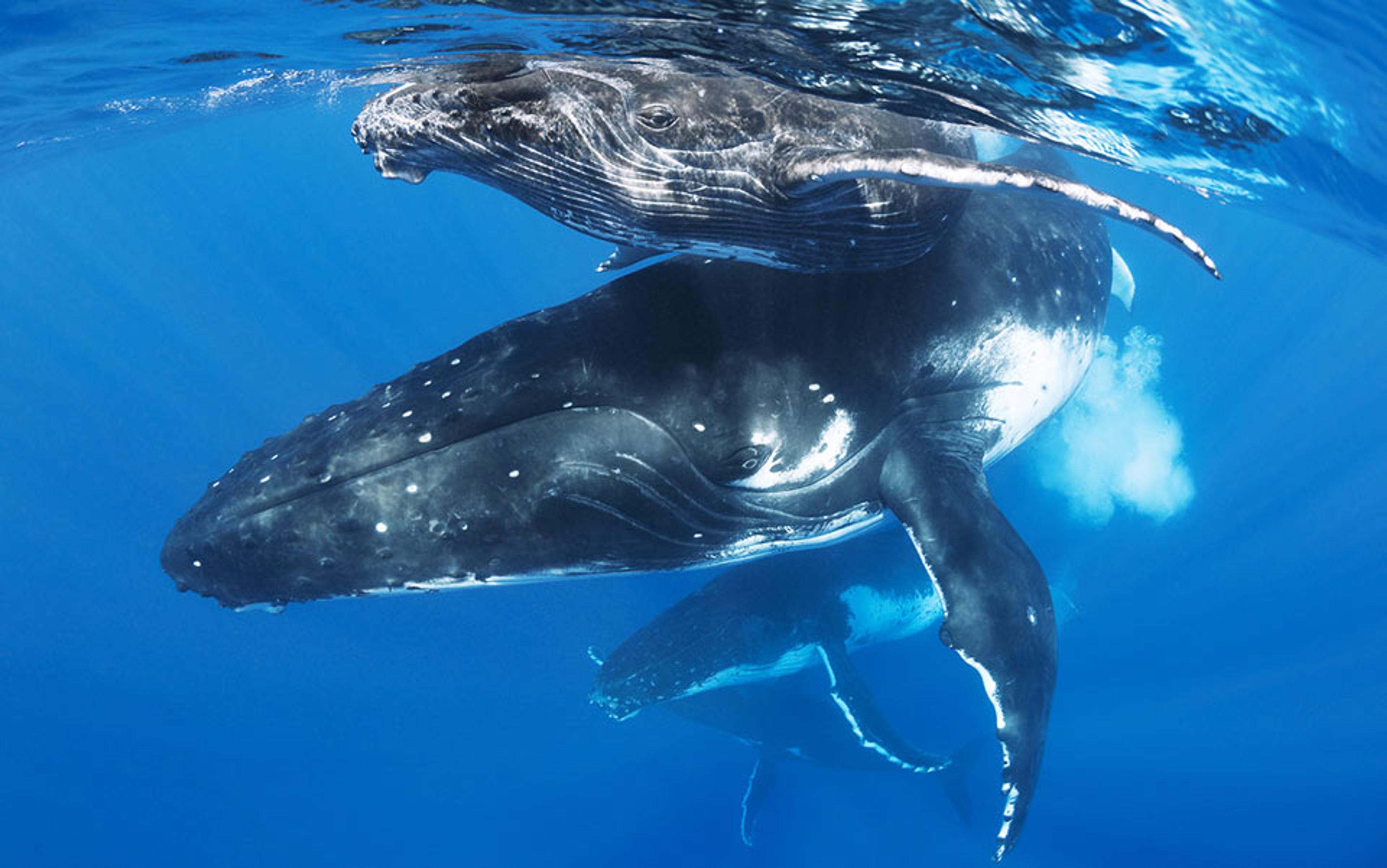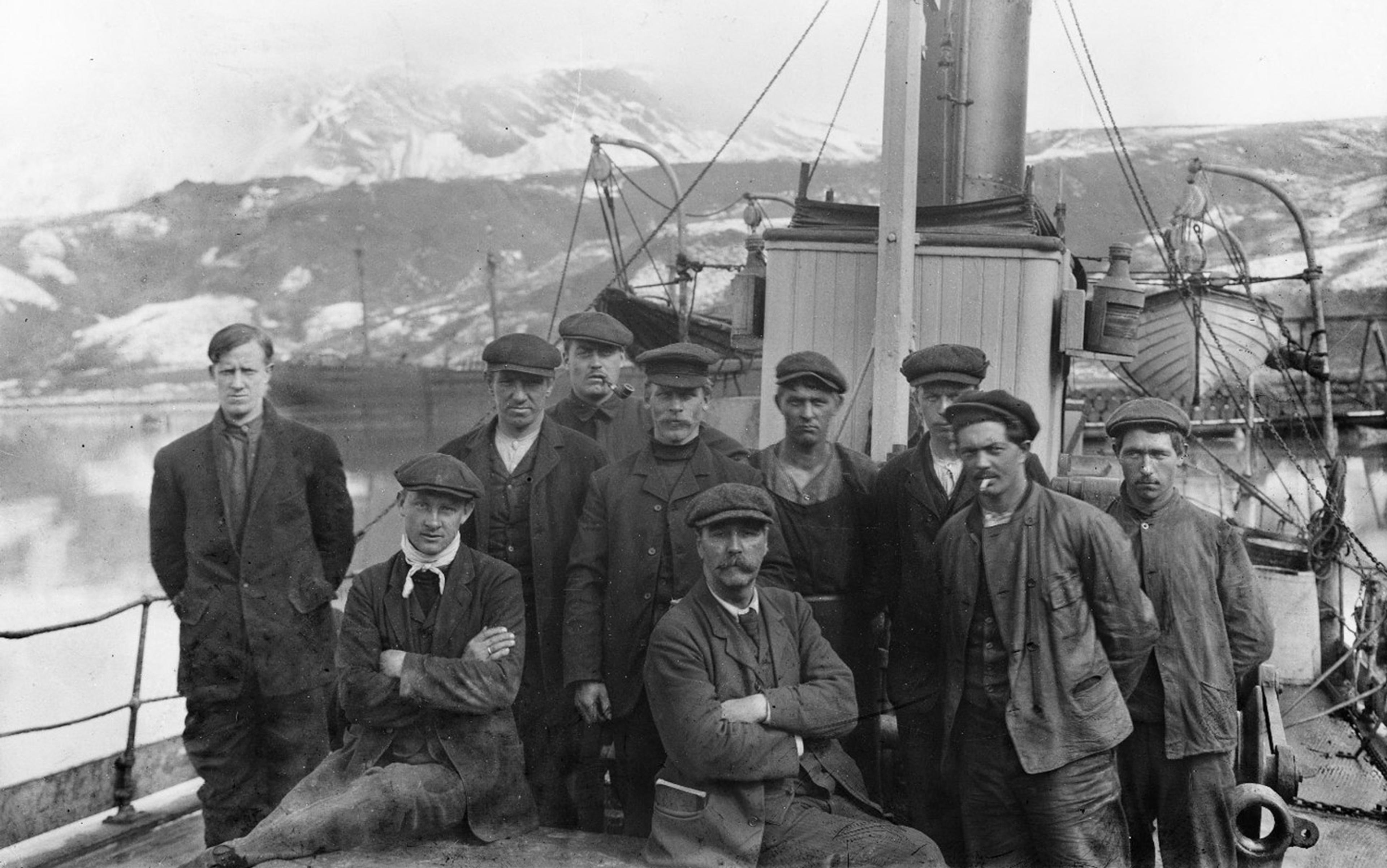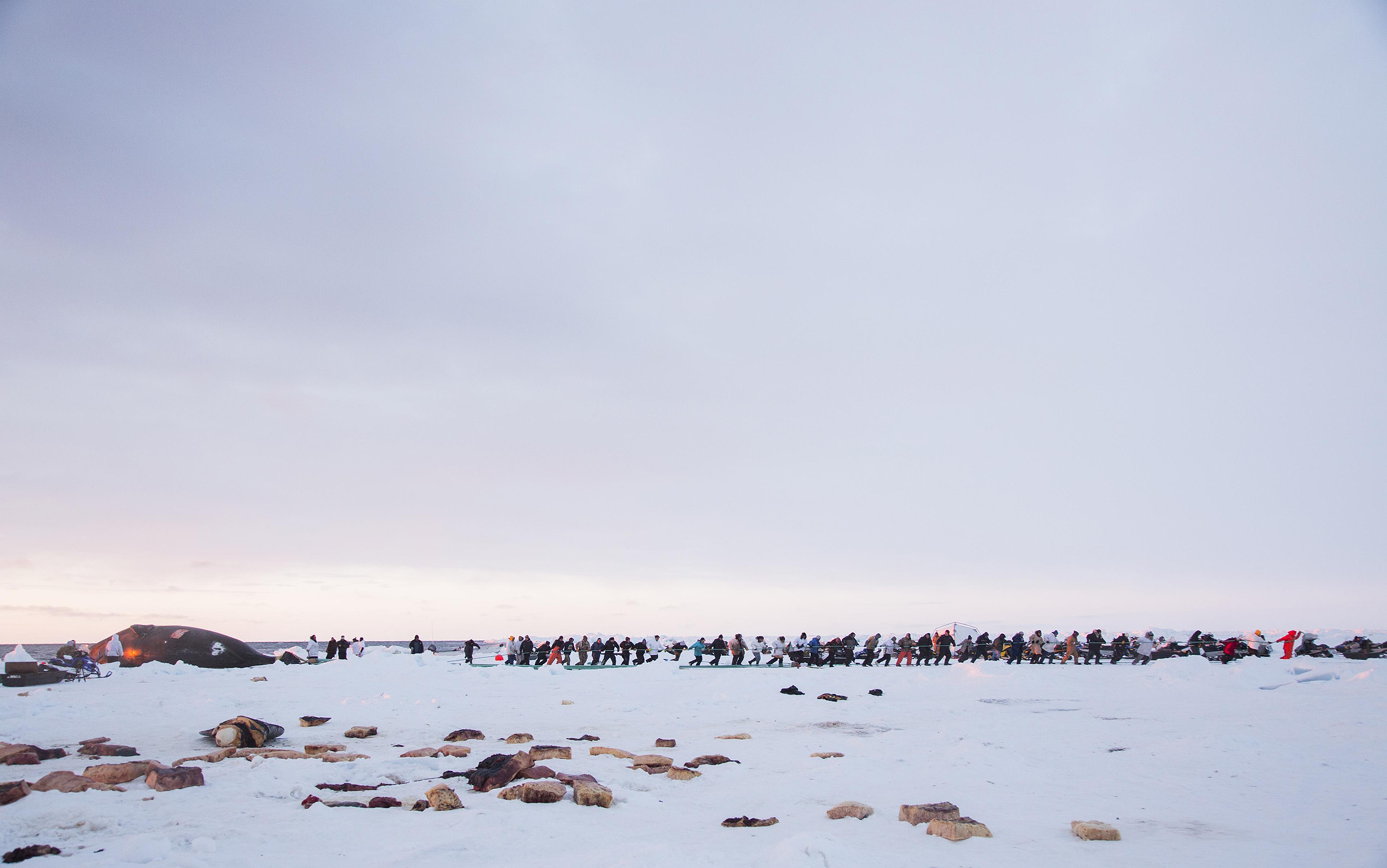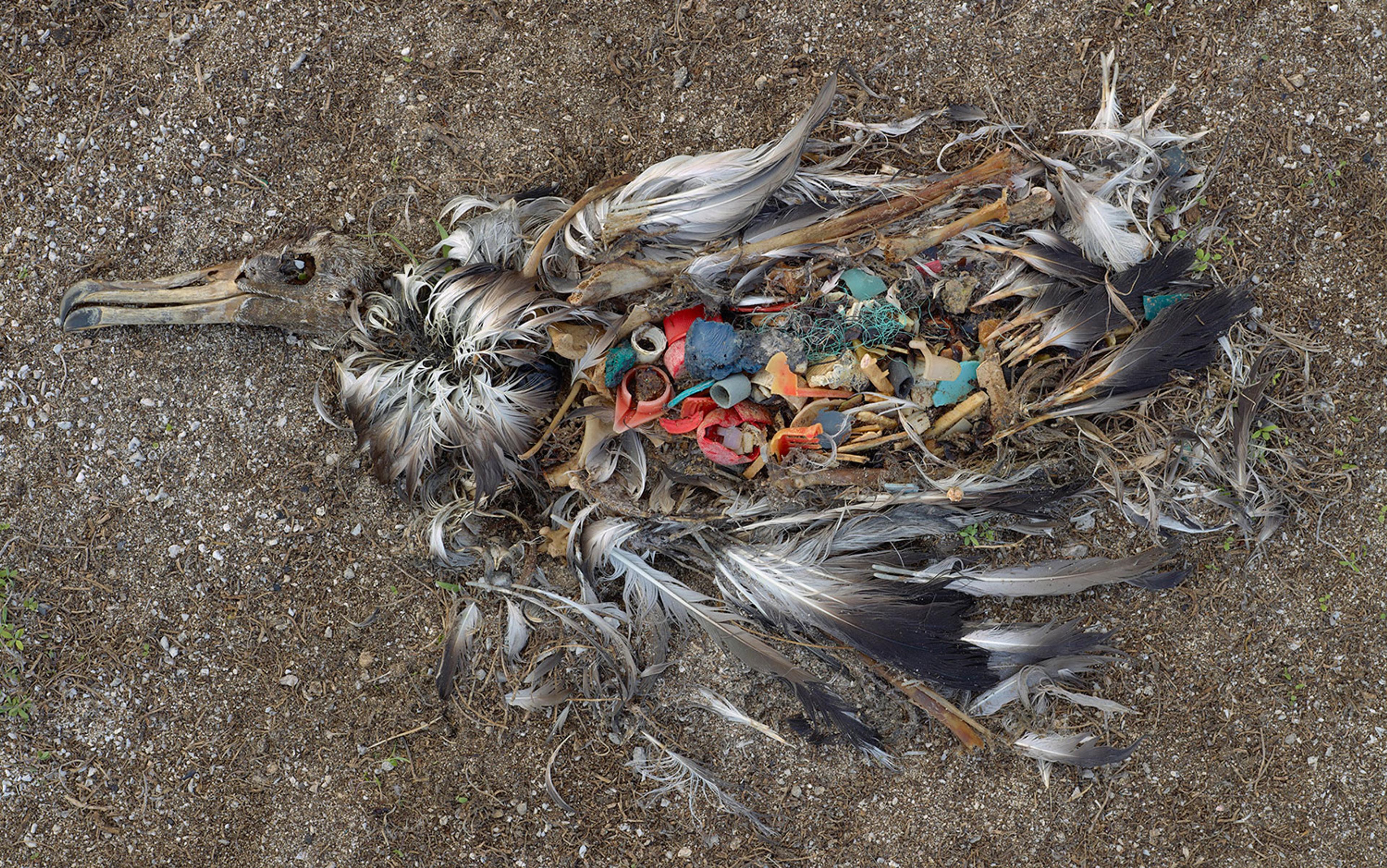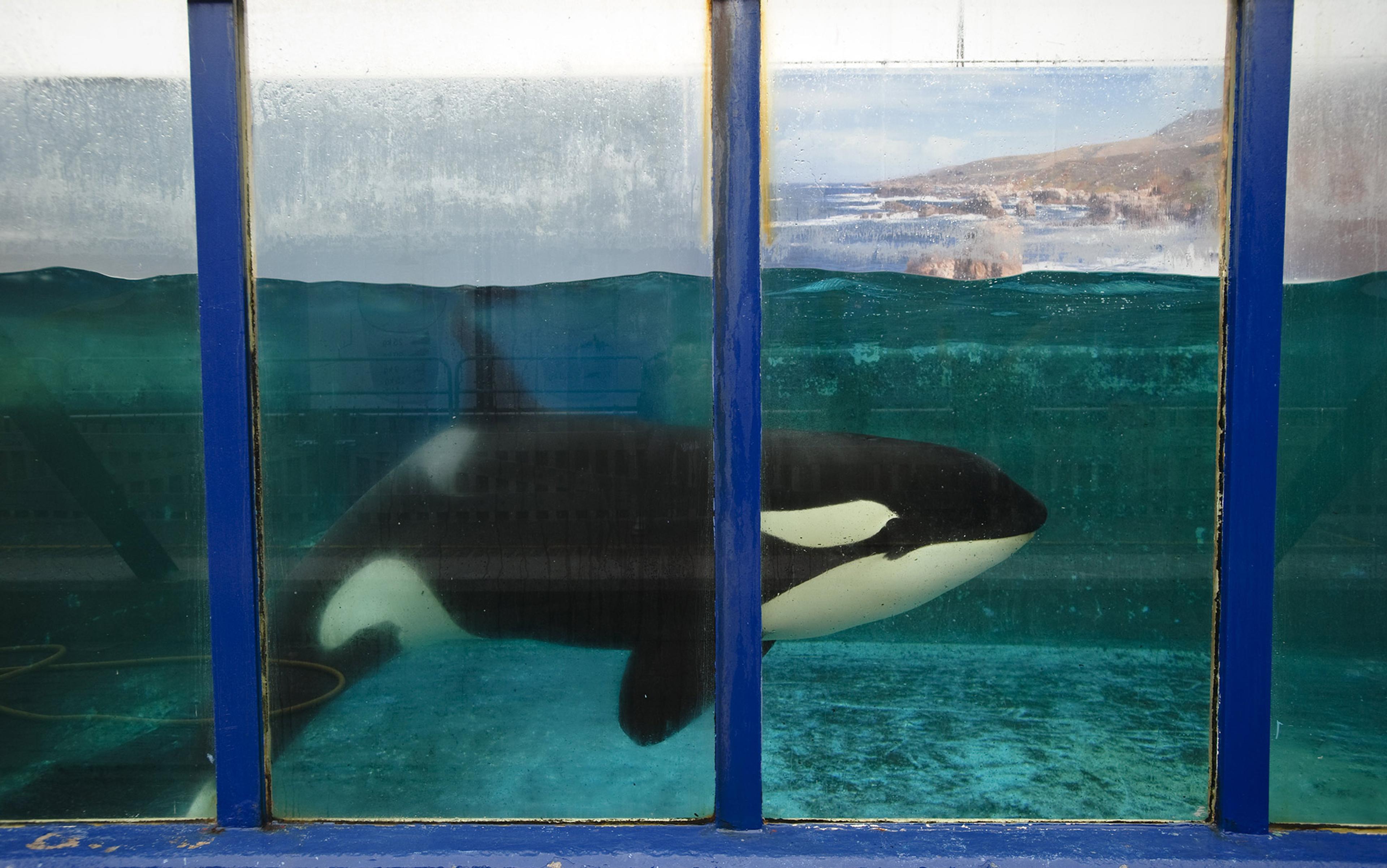‘It’s hard to believe that a 40-ton animal can get hidden. They’re sneaky.’ Charles ‘Stormy’ Mayo was scanning the sea from the deck of the R/V Shearwater searching for omens: a cloud of vapour, a patch of white water, a fluke. A few minutes earlier someone had spotted the first North Atlantic right whales of the day. But now they were down below and out of sight in 80 feet of murky seawater. Feeding, most likely.
Finally, a whale’s head emerged briefly on the sea surface. Then a slab of black back followed by the silhouette of flukes, signaling another deep dive. The appearance lasted maybe a second and a half. Groans from the crew, who did not quite manage to snap a photo that could help identify the whale, one of an early March influx that foretold another strong season in Cape Cod Bay. ‘There’s probably a bunch of whales here but it’s going to drive us crazy,’ Mayo chimed in. ‘I’m going to say there are probably three. It’s hard as hell to tell.’
The world’s rarest whales – Eubalaena glacialis – have been visiting the bay in late winter and early spring for as long as anyone can remember. But Mayo and his team at the Center for Coastal Studies (CCS) in Provincetown documented a puzzling uptick in recent years. Not just a few dozen animals, as was typical, but hundreds were showing up and, in one year, darn-near two-thirds of the world’s entire living population of around 500 North Atlantic right whales. ‘Right Whale Kingdom’ Mayo has called the bay. Simultaneously, the whales went AWOL from their usual summer feeding grounds 300 miles to the northeast in Canada’s Bay of Fundy and elsewhere, further mystifying researchers.
The Shearwater idled, waiting. The whales remained deep down, scooping up patches of zooplankton and straining out the seawater through the long strips of baleen in their mouths. Scooping and straining, scooping and straining. A change in the location of their preferred food is the most likely explanation for the whales’ wandering itinerary, Mayo said. Something is shifting out there in the ocean. As with so much else about their lives, only the whales know what it is.
Mayo co-founded CCS in 1976 and now directs its right whale research programme. For 30-odd years, he and scientists at a number of other institutions have amassed a remarkable body of evidence on these whales. They have employed time-tested observation methods from boats and planes to document the right whales’ demographics, movements, behaviour, biology and diet, and to catalogue sightings of individual whales. They’ve creatively investigated the whales’ genetics, health and sensory capabilities, all to figure out how to improve the critically endangered species’ chances of survival. Mayo told me that all this work, focused on a skimpy population, has made the North Atlantic right whale the most intensively researched whale on Earth, per individual animal. But whales are notoriously tricky to study, and many mysteries persist.
If the whale could speak, it could tell us about its experience as it plies thousands of ocean miles, mates, bears its calves, eats zooplankton, meets its challenges and, eventually, its end. It can’t, of course, but scientists have found that biochemical traces of some of its experiences persist in its body, even long after death. Just as geologists decode the history of the Earth from rocky strata, or dendrochronologists interpret past climactic conditions from tree rings, so biologists are now learning to read a whale’s life history as inscribed in its baleen. This anatomical oddity, part of a class of animal tissues that are emerging as tenacious biological recordkeepers, could reveal a monthly, even weekly, historical record of a whale’s life events stretching back as long as two decades. Just how much it will tell us remains to be seen.
‘This has become, like, my favourite piece of anatomy in the vertebrate world. Whale baleen is awesome!’ effused Kathleen Hunt, a wildlife endocrinologist until recently with the New England Aquarium in Boston. (She will join Northern Arizona University this fall.) She was standing in her office two winters ago, holding upright a piece of baleen that overtowered her by a good 18 inches.
The baleen came from a North Atlantic right whale nicknamed Stumpy who died in 2004 after colliding with a ship – a common cause of death among right whales. When scientists necropsied her corpse, they collected some of her baleen, not realising how useful it would later prove to be. Dark, hard, flexible and a little flaky, the texture of Stumpy’s baleen was reminiscent of horn, or a disturbingly overgrown fingernail. But at its worn tip and edges Hunt pointed out a surprise: a fringe of wispy hair, soft as a person’s. ‘The first time I saw this I had this revelation,’ Hunt said. ‘You look in the literature and it’s like “Baleen has a hair-like fringe.” And I’m like this is not just hair-like. It’s hair!’
In fact, baleen grows from densely compressed hair follicles, and is mostly composed of keratin, the protein common to hair, feather, horn, nail, hoof and skin. Across the dozen-plus species of baleen whale, the hair ranges in colour from peroxide blonde through red to nearly black. Some is coarse and bristly. With hundreds of baleen plates hanging in alignment from a whale’s upper jaws, this hairy fringe forms a dense thicket that traps prey as the whale flushes out mouthfuls of water. The plates grow continuously from the gumline, wearing away at the tips. Full-grown plates represent years or even decades of growth, depending on the species and maturity of the animal. Stumpy’s baleen probably captures the last 10 years of her life, Hunt told me.
This fundamental hairiness is what makes baleen such a potential trove of information. Over the past decade or so, researchers have been developing techniques for studying informative substances in hair, feathers, and other non-living keratin-based tissues in a variety of animals. These incorporate compounds circulating in the blood stream as they grow, preserving a record of an animal’s physiological past. This work is an extension of the analysis of human hair to reveal whether a person has used drugs or has been exposed to environmental toxins that is now being used in CSI-style investigations, as well as in medical research and employment law.
Typically, researchers consider blood to be the gold standard for studying animal physiology, but it is quite impossible to draw blood from a big, deep-diving whale at sea. ‘I have considered whales to be kind of a black box of biology because we’ve never been able to look inside their bodies,’ Hunt said. ‘It’s just so hard to tell, like what’s really going on in there? What are your hormone levels? What’s your heart rate? What’s your diet? What’s happening inside that big, beautiful body?’ In a quest for alternative windows into whales’ inner lives, she spent a decade methodically developing techniques for studying hormones in whale dung and breath in collaboration with Rosalind Rolland, a senior scientist at the aquarium. But such techniques still capture only a snapshot of a whale’s state at the time they are collected, Hunt said – nothing like a photo album revealing a sequence of important life events.
Currently, researchers might, at best, be able to patch together a spotty personal history if they happen to sight the same whale in the vast ocean over several years. But the only species scrutinised closely enough for that is the North Atlantic right whale and possibly some humpback groups. Even so, ‘You just have all these gaps in your data where you just have no idea what the animal was doing or whether it was breeding or where it was,’ Hunt said. This leads to all sorts of biological unknowns, such as the length and frequency of many whale species’ oestrus cycles and the length of their gestation.
‘There’s no other animal on the planet where we just know that little about basic reproduction’
For instance, scientists can determine how often whales reproduce and how many years they rest between births by spotting the same females travelling with calves in separate years. But for bowhead whales, which live in the Arctic, the remote habitat and harsh conditions make monitoring especially difficult. Scientists’ best guess as to their reproductive schedule comes from spotting a grand total of three females over the course of 35 years.
Things are certainly clearer for the better-studied right whales, but hardly picture-perfect. Later in the Shearwater’s cabin, Mayo told me that he and others have documented right whales’ orgiastic mating behaviour. There’s really no mistaking what’s going on. A female lies on her back, calling like crazy. Males rush in one after another, a dozen or more in a row. There’s lots of thrashing around, churning water. And plenty of visible whale penises ‘about as long as this cabin’, Mayo said, spreading his arms wide.
The only trouble is that he and others have seen the whales going at it at the ‘wrong’ times of year, considering that calves are born December through March. Which raises all kinds of questions: whether estimates of their gestation period are off, whether females might be able to store sperm and become pregnant at some later point, whether the whales might mate just for kicks. When it comes to whales, Hunt said: ‘There’s no other animal on the planet where we just know that little about basic reproduction.’
In 2012, as research in keratin-based tissues percolated in labs around the world, Raphaela Stimmelmayr, a biologist and wildlife veterinarian with North Slope Borough in Barrow, Alaska, who had been sending Hunt and Rolland bowhead poop for years, contacted the pair to suggest applying the keratin approach to baleen. ‘This suddenly got really exciting as soon as we realised we might be able to get a pregnancy signature out of the baleen,’ Hunt said. ‘There’s really been no way to reconstruct the history of an individual whale.’
Hunt, Rolland and several colleagues began with a pilot study published in 2014 of bowhead whales killed by native Alaskan hunters. Bowheads were a logical species to start with because these subsistence hunts are the one sustainable, fresh, reliable source of baleen, which you can get only from a dead whale. Also, bowheads, which are right whales’ closest relatives, have the longest- and slowest-growing baleen. An adult’s plate appears to capture 25 years of growth, longer than any other keratin-based tissue that has been studied.
The team was able to detect the stress hormone cortisol and the reproductive hormone progesterone in the baleen, and could clearly distinguish between males and females, and pregnant and non-pregnant females. Since baleen grows continuously, it doesn’t produce annual rings like a tree does; instead, the researchers used existing estimates of baleen growth rates as a chronometer for their samples. Best of all, when they looked by intervals at older baleen from mature females, they found changes in progesterone that neatly matched bowheads’ estimated gestation length. The baleen seemed to document past pregnancies.
What they needed to cross-check the technique was baleen from whales with known pregnancy histories. That’s where Stumpy and another ship-struck female North Atlantic right whale nicknamed Staccato came in. Both whales had a nearly 30-year-long file of regular sightings, including two recent pregnancies. And the carcasses of both happened to be found and dissected by scientists who had the foresight to collect plates of their baleen and tuck it away. ‘They’re really valuable plates,’ Hunt said.
Sure enough, sampling back in time at two-month – and, when things got interesting, at one-month or two-week – intervals along the two whales’ baleen, Hunt, Rolland and two colleagues found that progesterone spiked in sections that had grown during the documented pregnancies and dropped in sections that had grown when newborn calves appeared. ‘With whales, we’re all used to looking at very subtle patterns and patterns that are hard to pick up out of the data,’ Hunt said. Not this time: the pattern was ‘incredibly striking and obvious’, she said. When she revealed the results publicly for the first time at a marine mammal conference in December, the audience of researchers gasped audibly.
ship strikes and fishing-gear entanglement together caused half of the documented right-whale deaths since 1980
Baleen studies could help clear up some of the North Atlantic right whales’ basic reproductive biology, as well as more troubling mysteries. Just 14 calves were born this year, only 17 last year, and there have been several years-long stretches with almost no babies at all. The upshot is a 40 per cent decline in the birth rate since 2010. Many females just aren’t reproducing, and the percentage of females in the population is subtly dwindling. With just 500 animals, the species is in a real bind.
Researchers have pointed to several potential factors in these reproductive woes. There are all those collisions with ships. There are the whales’ shifting migration patterns, which suggest shifting zooplankton food supplies, possibly as a result of climate-change-induced warming sea temperatures. And there’s research by New England aquarium scientists showing that 83 per cent of the population bears scars from being snarled in fishing gear. (In fact, ship strikes and fishing-gear entanglement together caused half of the documented right-whale deaths since 1980 – they’re the species’ leading causes of death.)
If the females are miscarrying, Hunt said, disease or ship strikes might be the culprit. But if they just aren’t getting pregnant, the cause is more likely to be a lack of food or stress, perhaps due to entanglement or some other factor under human control. In fact, she said her team found the stress hormone cortisol in Stumpy and Staccato’s baleen, in patterns supporting the stressor idea – but of course data from two whales is hardly conclusive. ‘If there’s one thing I wish I could solve in the right whales,’ Hunt said, ‘just figuring out why they’re not breeding so much anymore would be so useful.’
Hunt and Rolland are optimistic that baleen analysis can go well beyond illuminating reproductive mysteries. Depending on what other compounds turn up in baleen, the potential is there for many studies in all of the dozen-plus species of baleen whale. The whale research community has pricked up its ears.
After the December conference, Hunt said she’s obtained baleen from humpback, fin, sei, blue, gray, minke and southern right whales. And there’s plenty of old baleen around from the whaling era. Baleen was the plastic of its day, and people used to make everything from corset stays to brooms to buggy whips out of it. Museums seem to have loads of it in dusty collections.
She said she is now ‘swimming’ in offers to collaborate and has heard rumours of a half-dozen labs taking up baleen analysis. ‘Basically, everybody with a hormone lab is jumping on this,’ she said.
baleen constitutes a long-term logbook of a whale’s whereabouts and a reliable seasonal chronometer
That stress hormone, cortisol, has drawn a lot of interest across wildlife biology because of its potential to reveal harmful influences. For instance, although bowheads are flourishing, Rolland said that, with their habitat changing fast as sea ice melts and ship traffic and noisy oil and gas exploration take off in the Arctic, ‘the ultimate goal’ of the baleen work ‘is to develop methods where we can assess stress related to environmental change and human activity’.
Other informative compounds besides hormones are turning up in baleen, too. A body of research dating to the 1980s shows that oscillations in the ratio of stable carbon and nitrogen isotopes along the length of bowhead baleen reflect the distinctive prey the whales find in their summer versus their fall and winter habitats. Essentially, baleen constitutes a long-term logbook of a whale’s whereabouts and a reliable seasonal chronometer. Researchers are looking at this pattern in bowhead baleen dating to 1952 to see whether the whales’ diet and migrations are changing, possibly due to shrinking sea ice. And with collaborators, Hunt and Rolland are studying isotope and hormone data in the same baleen to try to confirm bowheads’ gestation period and calving frequency. They think they’ll be able to tell not just when but roughly where individual bowheads got pregnant.
In fact, on occasion, bowheads’ very bodies are turning out to be historical exhibits. Native Alaskan hunters have found remarkably old whaling gear in slaughtered animals. In the 1990s, a stone tool turned up that had gone out of use in the 1880s. ‘When I saw that, I just remember… the blood running out of my head,’ said Craig George, a bowhead expert and wildlife biologist with North Slope Borough and a collaborator on several of the baleen studies. ‘I knew immediately that this was absolutely remarkable.’
Hunters found a few others over the years, George said, but you can’t reliably date stone tools. Then in 2007 a Yankee-era harpoon point with an 1879 patent turned up in the shoulder of another whale, placing the whale’s age at 115 to 130 years. George and his colleagues did chemical analyses of bowhead eye lenses that ultimately indicated they can live to 200 or older.
Studies of keratin-based tissues in other marine animals hint at baleen’s potential. For instance, a 2012 paper showed that cortisol is measureable in polar-bear hair from museum specimens dating back to 1892 – which was an early clue that scientists might eventually peer far back in time to learn how the health of wildlife populations has changed over the long haul. The paper’s lead author, Thea Bechshøft, an ecotoxicology postdoc at the University of Alberta, also showed that cortisol changes in polar bears’ hair with their exposure to certain endocrine-disrupting pollutants, and that it goes up in warm years when the sea ice they need for hunting shrinks and food is presumably scarce. Bechshøft is now looking at hormones, contaminants and other interesting molecules in porpoise and dolphin skin – which she collects by painlessly squeegeeing a thin sample from live animals. Archives of skin plugs make the technique potentially useful for historical analyses. Others are looking at hormones preserved in seal whiskers.
Late in the morning, Ryan Schosberg, an intern maintaining a lookout on the Shearwater’s deck, spotted two right whales a couple of miles ahead through binoculars. Then one behind. Then, up ahead, a smear of white water. The boat motored over to investigate, and suddenly it was surrounded.
Breaths echoed, like the hissing of air from immense tyres, as the whales surfaced briefly then dived again, sometimes just a few metres away. This time, they were sticking close to the surface and visible, by glimpses anyway, socialising instead of feeding. It turned out to be a group of right whales, one a young male with a distinctive facial scar, accompanied by a fin whale. Schosberg was busy keeping track of which whale was which, what they were doing, and marking it all down on a clipboard log sheet while another intern snapped photos. ‘The whales are being complicated,’ he joked. ‘It’d be great if they could just, like, all line up single-file.’
Elsewhere in the bay, an aircraft from CCS buzzing along predetermined track lines and another boat run by Mayo’s PhD student were also methodically searching the water for right whales to photograph, identify and add to the sightings catalogue.
Down in the Shearwater’s cabin, Mayo was at his laptop, central command, tallying up reports from the deck, the plane, the boat and the Shearwater’s crew who were periodically sampling the bay for plankton. ‘If you were anywhere else, one sighting of one right whale at a distance would be really exciting,’ Mayo said, adding that last year researchers monitoring no other spot in the entire North Atlantic saw as many as his team had already seen that day. In fact, many of the world’s right-whale researchers were getting ready to converge on Right Whale Kingdom for the spring, the one place on Earth they knew they could count on finding their study subjects.
Mayo’s family has been whaling or fishing the waters off Provincetown since 1656. He’s got an ancestral understanding of the ocean. And having studied right whales since 1984, he’s had plenty of time to observe their peculiarities at close quarters. Starting with their strange bodies. These are tubby, football-shaped beasts, but more flexible than any other whale he’s observed – so much so that they can touch their noses to their tails. They need to be supple to turn sharply in pursuit of zooplankton patches. And their tails are immense for a whale, huge propellers to push gaping, baleen-laden jaws through the water.
‘If you could translate their thought processes you would discover a vista of knowledge that is unlike anything we have about their aqueous world’
Then there’s their weirdly variable disposition. Mayo has watched right whales come over to his boat, swim calmly around it as if inspecting it for a time, and then without warning turn tail and flee. Sometimes they seem insensitive to their surroundings, he said, other times hypersensitive. ‘Everybody else says they’re just big dumb cows,’ he said.
‘My sense is that they have an understanding, although you’d have to test me on what I mean by understanding, but they have an understanding of the ocean that so far surpasses what we know of it and what our fancy electronics know of it. So I think that they are odd. And they’re odd in the depth of their knowledge,’ he said. ‘I think if you could – and there’s no way we can – but if you could translate their thought processes you would discover a vista of knowledge that is unlike anything we have about their aqueous world. They are probably extraordinarily finely tuned to characteristics of the sea that we don’t know anything about.’
Each whale is a perceptive messenger of the state of its species, the state of the cetaceans, the state of the oceans as a whole, as close and determined observation by Mayo and many others has shown. Now each piece of baleen is making those animals into messengers from the past, as we are expanding our own range of perception to understand.
By late afternoon, all eyes on the bay had spotted around 35 right whales – an impressive 7 per cent of the species’ entire struggling population. By the end of spring, about 35 per cent of the population had passed through Cape Cod Bay and its adjacent waters. And by the end of summer the whales had surprised everyone by reappearing on their historic summer feeding grounds in the Bay of Fundy and surrounds, albeit in lower numbers than before and several of them in alarmingly poor health. Others had shown up in waters further to the north.
Where were the hundreds of other right whales, though? Somewhere in the vast Atlantic, eating their zooplankton, nursing their calves, suffering their wounds – while subtly preserving the chemical signature of it all in their baleen. Scientists might someday learn the answer. For now, only the whales know.
